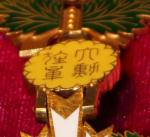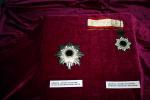-
Posts
1,721 -
Joined
-
Last visited
-
Days Won
3
Content Type
Profiles
Forums
Blogs
Gallery
Events
Store
Everything posted by Carol I
-

Fake insignia of the Order of Michael the Brave
Carol I replied to Carol I's topic in Central & Eastern European States
Thanks for the additional images, Emmanuel. -

Fake insignia of the Order of Michael the Brave
Carol I replied to Carol I's topic in Central & Eastern European States
Thanks Emmanuel for the update on this old thread. It seems that my first guess (erroneous pair) turned out to be true. -
I was not aware of any "class versions" of this cross. There are indeed two types of the medal depending on the years written on it, but other than that there are only maker versions. Take a look in the thread on the Commemorative Cross of the 1916-1918 War.
-
What makes this an "officer's version"?
-
The name was "The Order of the Crown of Romania with swords", knight class/grade on Military Virtue ribbon (indeed type I). Well, it had the crown on the centre medallion on the obverse. It was not until 1937 that the Order of the Crown of Romania acquired a suspension crown and even then it was only for the military grades.
-
This was actually referred to as "The Order of the Star of Romania with swords". It is indeed a fine example of the type II, Officer class on war ribbon.
-

Various - Eastern Europe ODM - A Magpie's Collection
Carol I replied to Hugh's topic in Southern European & Balkan States
What about jewelry tags? There are some with strings to be attached on the rings of the medals. Look for example on eBay in 'Jewelry & Watches > Jewelry Boxes, Cases & Display > Retail Packaging & Display > Tags, Price Tags'. -

Romania The Romanian Securitate
Carol I replied to Greg Collins's topic in Central & Eastern European States
'Tacake' does not sound right. The last name might be "Tacaks". Might be Gheorghe Stoica. -

Romania The Romanian Securitate
Carol I replied to Greg Collins's topic in Central & Eastern European States
No period was mentioned in the relation to the item, as fas as I remember. -

Romania The Romanian Securitate
Carol I replied to Greg Collins's topic in Central & Eastern European States
Greg, I have stumbled upon this (blurred) photo of a pair of old shoulder boards for an NCO of Militie. As you can see, they are quite similar to the ones on the uniform you posted (without the metal insignia, of course). -

Romania The Romanian Securitate
Carol I replied to Greg Collins's topic in Central & Eastern European States
The last pair I recognise, the other ones not. Besides, as far as I know, the chevrons were used only for technical personnel, at least in the later years. By the way, surfing the net, I have stumbled upon the text of the 1969 law regarding the organisation and functioning of Romanian police. You may find it useful, even though it is in Romanian. -

Romania The Romanian Securitate
Carol I replied to Greg Collins's topic in Central & Eastern European States
Greg, I also have some concerns regarding the uniform. I seem to remember the Militia unifoms as somewhat lighter in colour, but I have to admit that it's about 20 years since I've seen one. Regarding the shoulderboards, the ones on the uniform look like those of a lower grade NCO. As far as I can remember, the officers had shoulderboards similar to those of the army. There is actually a Police Museum in Romania with uniforms from all the periods. You could try to contact it for more informations regarding the uniforms. I have found on the net its coordinates. Address: Muzeul Naţional al Poliţiei Rom?ne, Calea Domnească nr. 187, Targoviste, Romania, Phone: +40-245-614060. -

Romania The Romanian Securitate
Carol I replied to Greg Collins's topic in Central & Eastern European States
I would translate De Strajă Patriei as Guarding the Homeland. I have found some references to this medal as an award for border guard troops. Defense of the Homeland would better be suited as the translation for Apărarea Patriei which was an order instituted in 1949. -

Romania Romania Hero of New Agricultural Revolution
Carol I replied to speedytop's topic in Central & Eastern European States
Unfortunately these could also be later strikes with the original dies. -

Romania The Romanian Securitate
Carol I replied to Greg Collins's topic in Central & Eastern European States
I guess you already know the links I indicated in this thread. I have heard that there are quite a few fakes of rare Romanian orders on the market, most likely those without cases and ribbon bars, so be aware. Unfortunately I cannot give further advice how to tell a fake from a genuine item. Other than that, good luck in your quest. -

Romania The Romanian Securitate
Carol I replied to Greg Collins's topic in Central & Eastern European States
I think the State Security Department was part of the Ministry of Internal Affairs even earlier, but due to the nature of its activities it had a special position. It had a relatively small number of employees in comparison to the number of its collaborators/informers recruited through a whole range of methods. Secret service/intelligence agency Police force "Gendarmerie" The information is indeed scarce, but I think that it was much less overlap than imaged. The Ministry of Internal Affairs was the big umbrella for both the police and the state security. Both departments had indeed attributes in internal affairs, but their nature differs. The police usually had assignments regarding individuals, while state security, as its name says, had more to do with state affairs. Anyhow, as I said before, it is quite possible that high ranking police officers also had positions in the state security (or vice versa), but that could be more a sign of separation of the duties of the two departments than of overlap. It is also possible that one department called the other if they realised that the things they investigated were of a different class. This is probably the safe approach, but some distinctions could still be made, e.g., a high ranking state security officer could have had police insignia, but that does not make any police insignia automatically a distinction of the state security. Unfortunately, as Kevin said, nowadays many items are being sold as Securitate based only on thin associations that are difficult if not impossible to prove. You really need to find the paperwork to prove the associations and that is not always available. Anyhow, because of all the uncertainties your collection would better be described as "security and militia", as you said it earlier, or even better "Ministry of Internal Affairs". -

Romania The Romanian Securitate
Carol I replied to Greg Collins's topic in Central & Eastern European States
I would not go that far. Dinamo was indeed the sporting club of the Ministry of Internal Affairs, but since this was not the same thing as the State Security Department I do not think that it was really the recruiting ground for the latter. On the other hand, I could imagine that many coaches of Dinamo were also instructors in the police schools. -

Romania Romanian Ribbon Bars
Carol I replied to Greg Collins's topic in Central & Eastern European States
The Military Merit Medal had only two classes - I and II - and they were indeed awarded for 10 and 5 years of service, respectively. -

Romania Romanian Ribbon Bars
Carol I replied to Greg Collins's topic in Central & Eastern European States
It could also had to do with the number of awards. 9 ribbons in rows of 4 would have looked 4-4-1, so probably they wanted to avoid the lone award on the third row (just another speculation, I know). -
Thanks Paul.
-
Thanks Paul for pointing this out. I suspected that there is something wrong when I noticed that the European designation of the classes had been used on the labels.
-
What is the meaning of the characters on the suspension device of the Supreme Order of the Chrysanthemum? Thanks.
-
Order of the Rising Star insignia in the collections of the National History Museum of Romania: grand cordon star and insignia of the third class
-

Romania The Romanian Securitate
Carol I replied to Greg Collins's topic in Central & Eastern European States
It depends on the award. The Order "In the Service of the Socialist Homeland (?n serviciul patriei socialiste) was for the members of the police and was the equivalent of the Order for Military Merit of the armed forces. On the other hand, the Order for Distinguished Merits in the Defense of the Social and State Order (Pentru merite deosebite aduse ?n apărarea or?nduirii sociale şi de stat) was destined for the members of the security services. -

Romania The Romanian Securitate
Carol I replied to Greg Collins's topic in Central & Eastern European States
Like any other secret service, the State Security Department usually kept a low profile for its activities. For obvious reasons, the members of its more elusive sections wore street clothing for their activities. It was also possible that some high ranking officers of the police were also officers of the State Security Department, but to what extent they had two uniforms I do not know. However, as I said before, the members of the Security Troops were those who routinely wore the uniforms with the distinctive blue colour. The lower ranks were conscripts who did thier military service with the Security Troops instead of the Army or Navy. Their duties resembled those of gendarmerie and indeed in the late 1940s they absorbed the personnel of the gendarmerie and in the 1990s they were reorganised again as the gendarmerie.





